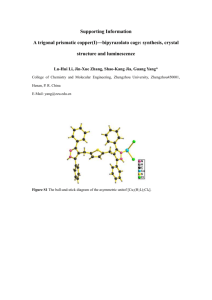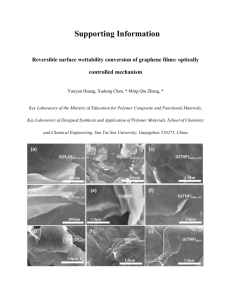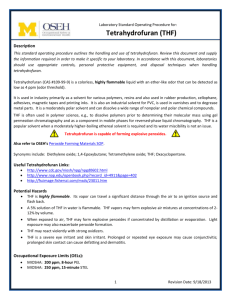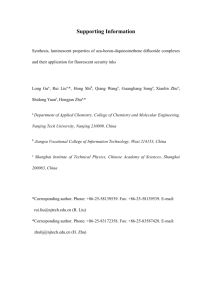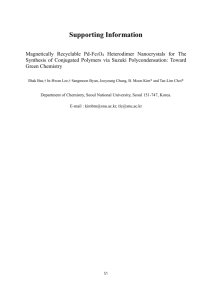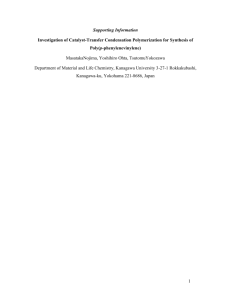Tetrahydrofuran - Environmental Health and Safety at Iowa State
advertisement
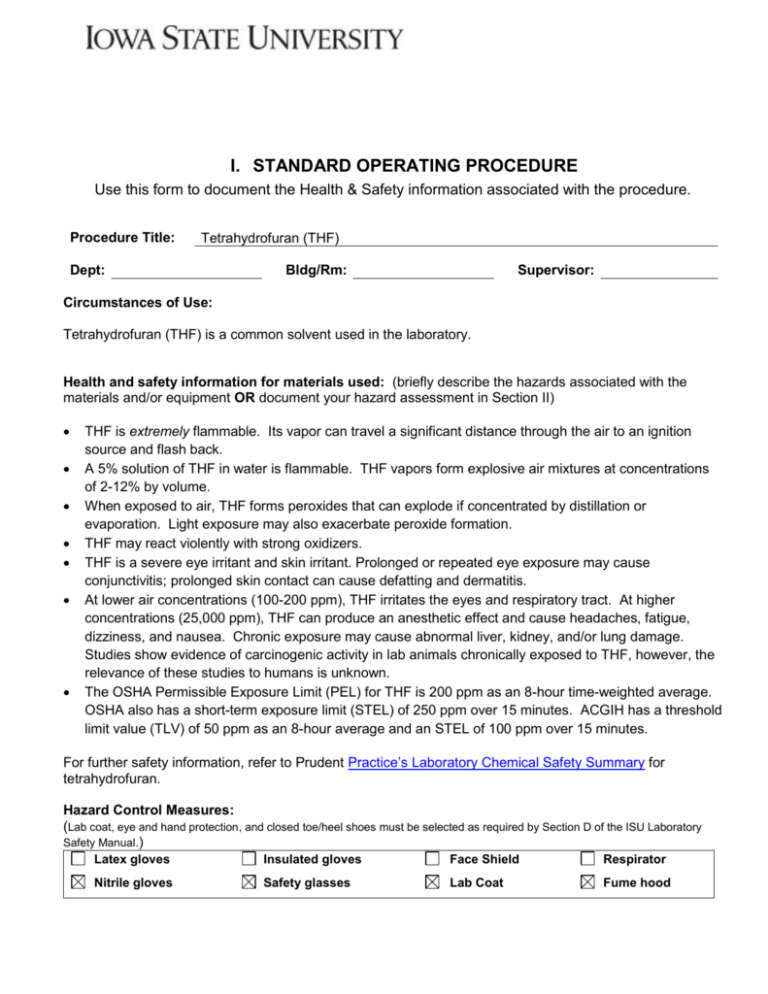
I. STANDARD OPERATING PROCEDURE Use this form to document the Health & Safety information associated with the procedure. Procedure Title: Tetrahydrofuran (THF) Dept: Bldg/Rm: Supervisor: Circumstances of Use: Tetrahydrofuran (THF) is a common solvent used in the laboratory. Health and safety information for materials used: (briefly describe the hazards associated with the materials and/or equipment OR document your hazard assessment in Section II) THF is extremely flammable. Its vapor can travel a significant distance through the air to an ignition source and flash back. A 5% solution of THF in water is flammable. THF vapors form explosive air mixtures at concentrations of 2-12% by volume. When exposed to air, THF forms peroxides that can explode if concentrated by distillation or evaporation. Light exposure may also exacerbate peroxide formation. THF may react violently with strong oxidizers. THF is a severe eye irritant and skin irritant. Prolonged or repeated eye exposure may cause conjunctivitis; prolonged skin contact can cause defatting and dermatitis. At lower air concentrations (100-200 ppm), THF irritates the eyes and respiratory tract. At higher concentrations (25,000 ppm), THF can produce an anesthetic effect and cause headaches, fatigue, dizziness, and nausea. Chronic exposure may cause abnormal liver, kidney, and/or lung damage. Studies show evidence of carcinogenic activity in lab animals chronically exposed to THF, however, the relevance of these studies to humans is unknown. The OSHA Permissible Exposure Limit (PEL) for THF is 200 ppm as an 8-hour time-weighted average. OSHA also has a short-term exposure limit (STEL) of 250 ppm over 15 minutes. ACGIH has a threshold limit value (TLV) of 50 ppm as an 8-hour average and an STEL of 100 ppm over 15 minutes. For further safety information, refer to Prudent Practice’s Laboratory Chemical Safety Summary for tetrahydrofuran. Hazard Control Measures: (Lab coat, eye and hand protection, and closed toe/heel shoes must be selected as required by Section D of the ISU Laboratory Safety Manual.) Latex gloves Insulated gloves Face Shield Respirator Nitrile gloves Safety glasses Lab Coat Fume hood Neoprene gloves Vented goggles Apron Biosafety cabinet Vinyl gloves Splash goggles Dust mask Glove box Closed Toe/Closed Heel Shoes Flame Resistant Lab coat Double-glove with neoprene or latex gloves, lab coat, and safety glasses for all work with THF. Note that THF permeates standard nitrile laboratory gloves in less than one minute and neoprene or latex in less than 2 minutes; thus, tasks should be planned to minimize glove contact with THF. If gloves become contaminated, change your gloves and wash your hands immediately to avoid skin exposure. If a splash may occur, chemical splash goggles and/or face shield must be worn. All work with THF should be done in a well-ventilated area. Work with large volumes or concentrated THF should be done in the fume hood. Work Practice Control Measures: Eliminate ignition sources such as open flames, hot surfaces, steam baths, and operation of mechanical and electrical equipment that is not intrinsically safe. Keep container closed when not in use to minimize creation of flammable vapor concentrations. Ensure proper grounding and avoid creating static electricity. Be sure to ground metal containers when transferring flammable liquids. Maintain the smallest amount necessary for ongoing work. Use in the smallest practical quantities for the experiment being performed. Never open a dented or otherwise compromised container of THF. Purchase THF with inhibitors added (for peroxide-forming) when possible. Due to its peroxide-forming hazard, THF containers should be dated upon receipt and at the time they are opened. If tested, note the date it was tested. Periodically test THF containers with peroxide test strips. Do not allow to evaporate to near dryness unless absence of peroxides has been shown. Consult the Safety Data Sheet (SDS) to determine how long an opened container can be used safely, and dispose of unused amounts after that period of time has passed (or if peroxides are found to be present by testing). Know the location of the nearest fire extinguisher before beginning work. Transportation and Storage: Transport THF in secondary containment, preferably a polyethylene or other non-reactive acid/solvent bottle carrier. THF should be stored with other flammables. Do not store THF near strong oxidizing agents, acids, bases, or organic alkali compounds. THF must be stored in an air-impermeable container and placed in a dark area to prevent further promotion of the peroxide-forming reaction. Suitable fire control devices (such as fire extinguishers) must be available at locations where flammable or combustible liquids are stored. Contact EH&S Fire Safety at 515-294-5359 for installation of appropriate devices. Open flames shall not be permitted in flammable or combustible liquid storage areas. A “No Open Flames” sign must be conspicuously posted in these areas. Avoid storing THF on the floor. Flammable liquids shall not be stored in unapproved or residential-type refrigerators. Waste Disposal Procedures: Contact EH&S Environmental Programs at 4-5359 immediately to arrange for pick-up and disposal. Handle and store chemical waste following the guidelines above while accumulating wastes and awaiting chemical waste pickup. Waste must be disposed of following the Waste and Recycling Guidelines. http://www.ehs.iastate.edu/sites/default/files/uploads/publications/manuals/warg.pdf First Aid Procedures: General advice Consult a physician. Show the SDS to the attending physician. In case of skin contact Immediately wash with soap and water and remove contaminated clothing. Flush skin with plenty of water for at least 15 minutes. In case of eye contact Immediately rinse eyes with copious amounts of water for 15 minutes while occasionally lifting upper and lower eyelids. Seek medical attention. If inhaled Move the person to fresh air immediately and seek medical attention if large amounts were inhaled. If swallowed Seek medical attention immediately. All accidents and injuries occurring at work or in the course of employment must be reported to the employee's supervisor as soon as possible (even if no medical attention is required). http://www.ehs.iastate.edu/occupational/accidents-injuries Spill/Release Containment, Decontamination, and Clean Up Procedures: Spills of THF inside a chemical fume hood, or small spills outside a hood, may be cleaned by laboratory personnel. Appropriate gloves should be worn since THF readily penetrates standard laboratory nitrile, neoprene, and latex gloves and glove contact will occur during cleanup. Silvershield gloves should be used for spill cleanup. Since THF is a peroxide-forming material, do not allow clean-up materials to dry – seal them inside a compatible container. Only use non-flammable material to absorb spills. Call EH&S 4-5359 immediately for pick-up of spill clean-up materials. Large spills of volatile hazardous materials must be referred to EH&S 4-5359. Using Substances Requiring Special Procedures? No Yes (If Yes; identify authorized personnel, designate a use area and specify specialized safety precautions here. Refer to Section B in the ISU Laboratory Safety Manual for details.) Written By: Date: Approved By: Date: (PI or Lab Supervisor) II. HAZARD ASSESSMENT Use the hierarchy of controls to document the hazards and the corresponding control measure(s) involved in each step of the procedure. Consider elimination or substitution of hazards, if possible. Engineering Control(s): items used to isolate the hazard from the user (i.e. fume hood, biosafety cabinet). Administrative Control(s): policies/programs to limit the exposure to the hazard (i.e. authorizations, designated areas, time restrictions, training). Required PPE: indicate PPE including specific material requirements if applicable (i.e. flame resistant lab coat, type of respirator or cartridge). Hazard Engineering Control(s) III. Administrative Control(s) Required PPE Training Record Use the following table to record the training associated with this Standard Operating Procedure. Print Name Signature Note: Attach to or file with written materials and methods Date

